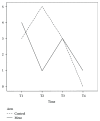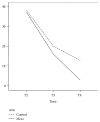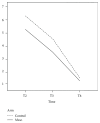Efficacy of Mesoglycan in Pain Control after Excisional Hemorrhoidectomy: A Pilot Comparative Prospective Multicenter Study
- PMID: 29743886
- PMCID: PMC5884030
- DOI: 10.1155/2018/6423895
Efficacy of Mesoglycan in Pain Control after Excisional Hemorrhoidectomy: A Pilot Comparative Prospective Multicenter Study
Abstract
Introduction: Various pain management strategies for patients undergoing open excisional hemorrhoidectomy have been proposed, yet postoperative pain remains a frequent complaint.
Objective: To determine whether mesoglycan (30 mg two vials i.m. once/day for the first 5 days postoperative, followed by 50 mg 1 oral tablet twice/day for 30 days) would reduce the edema of the mucocutaneous bridges and thus improve postoperative pain symptoms.
Patients and methods: For this prospective observational multicenter study, 101 patients undergoing excisional diathermy hemorrhoidectomy for III-IV degree hemorrhoidal disease were enrolled at 5 colorectal referral centers. Patients were assigned to receive either mesoglycan (study group SG) or a recommended oral dose of ketorolac tromethamine of 10 mg every 4-6 hours, not exceeding 40 mg per day and not exceeding 5 postoperative days according to the indications for short-term management of moderate/severe acute postoperative pain, plus stool softeners (control group CG).
Results: Postoperative thrombosis (SG 1/48 versus CG 5/45) (p < 0.001) and pain after rectal examination (p < 0.001) were significantly reduced at 7-10 days after surgery in the mesoglycan-treated group, permitting a faster return to work (p < 0.001); however, in the same group, the incidence of postoperative bleeding, considered relevant when needing a readmission or an unexpected outpatient visit, was higher, possibly owing to the drug's antithrombotic properties.
Conclusions: The administration of mesoglycan after an open diathermy excisional hemorrhoidectomy can reduce postoperative thrombosis and pain at 7-10 days after surgery, permitting a faster return to normal activities.
Figures




Similar articles
-
Mesoglycan for pain control after open excisional HAEMOrrhoidectomy (MeHAEMO): an observational multicentre study on behalf of the Italian Society of Colorectal Surgery (SICCR).BMC Surg. 2020 Oct 22;20(1):251. doi: 10.1186/s12893-020-00914-5. BMC Surg. 2020. PMID: 33092570 Free PMC article. Clinical Trial.
-
Short-term Outcomes of Transanal Hemorrhoidal Dearterialization With Mucopexy Versus Vessel-Sealing Device Hemorrhoidectomy for Grade III to IV Hemorrhoids: A Prospective Randomized Multicenter Trial.Dis Colon Rectum. 2019 Aug;62(8):988-996. doi: 10.1097/DCR.0000000000001362. Dis Colon Rectum. 2019. PMID: 30807456 Clinical Trial.
-
Clinical evidence and rationale of mesoglycan to treat chronic venous disease and hemorrhoidal disease: a narrative review.Updates Surg. 2024 Apr;76(2):423-434. doi: 10.1007/s13304-024-01776-9. Epub 2024 Feb 14. Updates Surg. 2024. PMID: 38356039 Free PMC article. Review.
-
Diathermy excisional hemorrhoidectomy: a prospective randomized study comparing pedicle ligation and pedicle coagulation.Dis Colon Rectum. 2011 Nov;54(11):1405-11. doi: 10.1097/DCR.0b013e318222b5a9. Dis Colon Rectum. 2011. PMID: 21979186 Clinical Trial.
-
[Necessary and unnecessary treatment options for hemorrhoids].Ther Umsch. 2014 Dec;71(12):737-51. doi: 10.1024/0040-5930/a000620. Ther Umsch. 2014. PMID: 25447089 Review. German.
Cited by
-
Thrombosed external hemorrhoids during pregnancy: surgery versus conservative treatment.Updates Surg. 2024 Apr;76(2):539-545. doi: 10.1007/s13304-023-01741-y. Epub 2023 Dec 27. Updates Surg. 2024. PMID: 38151682 Clinical Trial.
-
Efficacy and Safety of Snap Needles in the Treatment of Postoperative Hemorrhoidal Pain: A Systematic Review and Meta-Analysis.J Pain Res. 2024 Jun 7;17:2015-2028. doi: 10.2147/JPR.S464176. eCollection 2024. J Pain Res. 2024. PMID: 38863870 Free PMC article.
-
Polyherbal formulation Anoac‑H suppresses the expression of RANTES and VEGF for the management of bleeding hemorrhoids and fistula.Mol Med Rep. 2021 Oct;24(4):736. doi: 10.3892/mmr.2021.12376. Epub 2021 Aug 20. Mol Med Rep. 2021. PMID: 34414451 Free PMC article.
-
The comparison of doppler-guided haemorrhoidal artery ligation and the tissue selecting technique for patients with grade III/IV haemorrhoids: a retrospective cohort study.Updates Surg. 2025 Aug;77(4):1085-1094. doi: 10.1007/s13304-025-02202-4. Epub 2025 Apr 10. Updates Surg. 2025. PMID: 40210842
-
Management and Treatment of External Hemorrhoidal Thrombosis.Front Surg. 2022 May 3;9:898850. doi: 10.3389/fsurg.2022.898850. eCollection 2022. Front Surg. 2022. PMID: 35592120 Free PMC article. Review.
References
-
- Infantino A., Altomare D. F., Bottini C., et al. Prospective randomized multicentre study comparing stapler haemorrhoidopexy with Doppler-guided transanal haemorrhoid dearterialization for third-degree haemorrhoids. Colorectal Disease. 2012;14(2):205–211. doi: 10.1111/j.1463-1318.2011.02628.x. - DOI - PubMed
-
- Aigner F., Kronberger I., Oberwalder M., et al. Doppler-guided haemorrhoidal artery ligation with suture mucopexy compared with suture mucopexy alone for the treatment of Grade III haemorrhoids: a prospective randomized controlled trial. Colorectal Disease. 2016;18(7):710–716. doi: 10.1111/codi.13280. - DOI - PubMed
-
- Similis C., Thoukididou S. N., Slesser A. A., Rasheed S., Tan E., Tekkis P. P. Systematic review and network meta-analysis comparing clinical outcomes and effectiveness of surgical treatments for haemorrhoids. The British Journal of Surgery. 2015;102(13):1603–1618. doi: 10.1002/bjs.9913. - DOI - PubMed
LinkOut - more resources
Full Text Sources
Other Literature Sources
Medical

